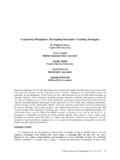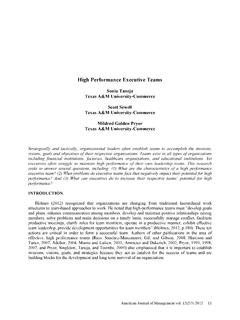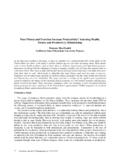Transcription of Revisiting Hofstede’s Dimensions: Examining the …
1 Revisiting hofstede s dimensions : Examining the Cultural Convergence of the United States and Japan Erich B. Bergiel University of West georgia Blaise J. Bergiel University of West georgia John W. Upson University of West georgia It has been over forty years since hofstede s groundbreaking study on cultural values. Since then, there have been drastic changes to the global landscape influenced by political, environmental, and technological factors. Utilizing Cultural Convergence Theory we suggest that increased similarities can be observed in cultures with strong international linkages. Specifically, this study utilized the new Value Survey Module 08 to test theoretically justified hypotheses Examining the cultural convergence of the United States and Japan.
2 Results suggest interesting changes have occurred in these cultures, to include a strong trend towards convergence. Implications as well as directions for future research are discussed. INTRODUCTION Success in the global market depends on understanding the cultures you are doing business with. For this reason, studies on work-related cultural values continue to show prominence in both industrial and organizational research. The framework for most of this research can be attributed to Geert hofstede and his initial four dimensions of cultural values, as well as his Value Survey Module (VSM) to capture these dimensions ( hofstede , 1984). The reviews of cross-cultural studies have suggested that hofstede -inspired research is increasing exponentially (Taras, Kirkman & Steel, 2010).
3 The intent of this current study is to continue this trend while attempting to address potential short-comings in recent cross-cultural research. The most prevalent short-coming is that researchers still reference hofstede s original findings or outdated versions of the VSM for empirical or theoretical support. The challenge of cross-cultural research is to attempt to stay abreast of evolving cultures by evolving our methods of analysis and observation as well. The latest iteration of the VSM has three additional dimensions that were not measured in the original module. However few researchers have utilized this tool to assess values across cultures. To adequately advance cross-cultural research it is essential to use the most advanced available methods.
4 In order to accomplish this we have two primary objectives. First, this study has collected data from the United States and Japan in order to provide updated information on work-related values of these two cultures. The data was collected to test theoretically justified hypothesis that state that countries with American Journal of Management vol. 12(1) 69 strong international ties like the United States and Japan will undoubtedly inflict their own values and beliefs on the evolving culture of the other, potentially causing a convergence of these two cultures. Second, the data was collected using the most recent VSM 08. The researchers undertook the task of both conducting the initial translation of the VSM 08 into Japanese and collecting the first results from Japanese respondents.
5 Cultures evolve and so should the methods used to assess them. The VSM 08 is the most current method and this study will not only provide an additional translation of the VSM 08 but it will also further validate it as an assessment tool. A REVIEW OF hofstede S VALUE dimensions In hofstede s original study data was collected from a large multinational business corporation (IBM) with subsidiaries in 64 countries. The data consisted of answers to questions about their values and perceptions of their work situation. Careful post-analysis of the initial and subsequent surveys started to show a global structure that could not be suppressed by the idiosyncrasies of the individual countries ( hofstede et al., 1990, p. 288).
6 This initial structure consisted of four individual cultural value dimensions . The first dimension is power distance. According to hofstede (1984), power distance is the extent to which the less powerful individuals in a society accept inequality in power and consider it as normal. In high power distance cultures, individuals respect their superiors and avoid criticizing them. In low power distance countries, it is very acceptable to challenge superiors, albeit with respect. The second dimension is individualism collectivism, which reflects the degree to which a society views its members as individuals or as group members ( hofstede , 1984). In individualistic societies, individuals are primarily concerned with their own interests and the interests of their immediate family.
7 In highly collectivistic societies, individuals are not defined by their own actions but rather the groups actions. The third dimension is masculinity femininity, with masculinity described as cultures where the dominant values are expected to be ambitious, assertive, and competitive. In contrast, in cultures high in femininity there is a dominance of feminine values such as preference for friendly atmosphere, position security, physical conditions [and] security ( hofstede , 2001, ). Fourth, uncertainty avoidance is the degree to which people in a culture generally prefer structure to risk ( hofstede , 1984). Cultures high in uncertainty avoidance are made anxious by situations that are unstructured, unclear, or unpredictable.
8 On the other hand, cultures low in uncertainty avoidance are reflective, less aggressive, relatively tolerant, and unemotional. Subsequent research initiated by Michael Harris Bond (Chinese Culture Connection, 1987) revealed a fifth meaningful dimension. This dimension originally labeled Confucian dynamism represented the opposing views time orientation has on life and work ( hofstede et al., 1990). This dimension, later termed long-term orientation, refers to the preference for instant reward versus delayed reward ( hofstede & Bond, 1988). More recently, Minkov (2007) proposed three new dimensions : Exclusionism Universalism, Indulgence Restraint, and Monumentalism Flexhumity. From these, post-analysis found that exclusionism universalism was strongly correlated with power distance and collectivism so it was not been treated as a new dimension.
9 However, the remaining dimensions were. The indulgence restraint dimension considers indulgence as the value that a society places on relatively free gratification of desires and feelings (Fontaine et al. 2005). Opposite indulgence is restraint, or the values which control such gratification and place limits on individuals enjoyment behaviors. Monumentalism refers to the cultural dimension characterized on one extreme by self-enhancement (a tendency to seek positive information about oneself) and self-stability or self-consistency (a conviction that one should have unchangeable values, beliefs and behaviors that are not influenced by shifting circumstances) (Heine, 2003). At the other extreme are flexhumble cultures.
10 Flexhumity is characterized by humility, flexibility and adaptability to changing circumstances ( hofstede & Minkov, 2010). hofstede released the most recent Values Survey Module in 2008 (VSM 08). In this survey, hofstede measured his five dimensions of culture, and included the two additional dimensions he derived from Michael Minkov ( hofstede , hofstede , Minkov & Vinken, 2008, p. 2). We argue that as cultures evolve 70 American Journal of Management vol. 12(1) they must constantly be assessed with respect to each of hofstede s seven cultural dimensions . We base the argument on the belief that culture is dynamic and evolving due to influential interactions with other cultures, a belief rooted in Cultural Convergence Theory (Barnett & Kincaid, 1983).












